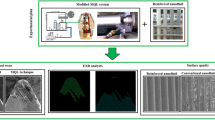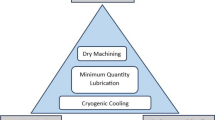Abstract
The superiority of minimal nanolubrication for effective, efficient and cleaner machining environment has been widely discussed in the literature. However, due to their high surface energy, nanoparticles coagulate or agglomerate easily, which makes it difficult to disperse them in the base fluid. Hence, the addition of a small amount of surfactant should be able to overcome this issue. This research elucidates and extends fundamental knowledge regarding the effect of a sodium dodecyl benzene sulfonate surfactant mixed with different nanoparticle concentrations towards the sustainable machining of titanium alloy using design of experiment methodology. The experimental results indicate that the inclusion of a sodium dodecyl benzene sulfonate surfactant in aluminium oxide nanolubricant provides the best lubricating properties for the machining of the titanium alloy. At 0.4 wt% of nanoparticles and a feed rate of 0.1 mm/rev, minimum values of surface roughness and power consumption can be achieved. Meanwhile, minimal tool wear can be attained by application of a 0.6 wt% nanoparticle concentration and 0.1 mm/rev feed rate. Further statistical analyses emphasized that the feed rate was the most significant factor that influenced the surface roughness and power consumption, while the mixture of nanoparticles with surfactant and feed rate has the greatest effect on the tool wear resistance of the cutting insert.
Similar content being viewed by others

References
Shokrani A, Dhokia V, Newman ST (2012) Environmentally conscious machining of difficult-to-machine materials with regard to cutting fluids. Int J Mach Tools Manuf 57:83–101
Lawal SA, Choudhury IA, Nukman Y (2013) A critical assessment of lubrication techniques in machining processes: a case for minimum quantity lubrication using vegetable oil-based lubricant. J Clean Prod 41:210–221
Debnath S, Reddy MM, Yi QS (2014) Environmental friendly cutting fluids and cooling techniques in machining: a review. J Clean Prod 83:33–47
Wang XJ, Zhu DS, Yang S (2009) Investigation of pH and SDBS on enhancement of thermal conductivity in nanofluids. Chem Phy Letters 470(1–3):107–111
Najiha MS, Rahman MM, Yusoff AR (2016) Environmental impacts and hazards associated with metal working fluids and recent advances in the sustainable systems: a review. Renew Sust Energ Rev 60:1008–1031
Sayuti M, Sarhan AAD, Salem F (2014b) Novel uses of SiO2 nano-lubrication system in hard turning process of hardened steel AISI4140 for less tool wear, surface roughness and oil consumption. J Clean Prod 67:265–276
Najiha MS, Rahman MM (2016) Experimental investigation of flank wear in end milling of aluminum alloy with water-based TiO2 nanofluid lubricant in minimum quantity lubrication technique. J Clean Prod. In Press
Rahmati B, Sarhan AAD, Sayuti M (2014) Morphology of surface generated by end milling Al6061-T6 using molybdenum disulfide (MoS2) nanolubrication in end milling machining. J Clean Prod 66:685–691
Uysal A, Demiren F, Altan E (2015) Applying minium quantity lubrication (MQL) method on milling martensitic steel by using nano MOS2 reinforced vegetable cutting fluid. Procedia - Soc Beh Sci 195:2742–2747
Setti D, Sinha MK, Ghosh S, Rao PV (2015) Performance evaluation of Ti-6Al-4 V grinding using chip formation and coefficient of friction under the influence of nanofluids. Int J Mach Tools Manuf 88:237–248
Padmini R, Vamsi Krishna P, Krishna Mohana Rao G (2016) Effectiveness of vegetable oil based nanofluids as potential cutting fluids in turning AISI 1040 steel. Tri Int 94:490–501
Chen Q, Wang X, Wang Z, Liu Y, You T (2013) Preparation of water-soluble nanographite and its application in water-based cutting fluid. Nanoscale res. Letters 8(1):1–8
Kedzierski MA (2013) Viscosity and density of aluminum oxide nanolubricant. Int J Ref 36(4):1333–1340
Abd-elaal AA (2014) Use of surfactants in metal cutting fluids formation. 259–281
Sayuti M, Erh OM, Sarhan AAD, Hamdi M (2014) Investigation on the morphology of the machined surface in end milling of aerospace AL6061-T6 for novel uses of SiO2 nanolubrication system. J Clean Prod 66:655–663
Ali MAM, Khalil ANM, Azmi AI (2015) Effect of minimum quantity lubricant of Al203 nanoparticle with SDBS on surface roughness during turning of mild steel. Adv Mater Res 1119:75–79
Ali MAM, Khalil ANM, Azmi AI (2016) Effect of Al2O3 nanolubrication with sodium Dodecylbenzene sulfonate (SDBS) on surface roughness and tool wear under MQL during turning of Ti-6AL-4 V. IOP Conf Ser: Mater Sci Eng 114:1–6
Stephenson DA, Agapiou JS (2006) Metal cutting theory and practice. CRC Press, Taylor & Francis, Boca Raton, Florida
Sulaiman MA, Che Haron CH, Ghani JA, Kasim MS (2013) Optimization of turning parameters for titanium alloy Ti-6Al-4 V ELI using the response surface method (RSM). J Adv Manuf Technol 7(2):11–28
Sayuti M, Sarhan AAD, Hamdi M (2013) An investigation of optimum SiO2 nanolubrication parameters in end milling of aerospace Al6061-T6 alloy. Int J Adv Manuf Technol 67:833–849
Selvaraj DP, Chandramohan P, Mohanraj M (2014) Optimization of surface roughness, cutting force and tool wear of nitrogen alloyed duplex stainless steel in a dry turning process using Taguchi method. Meas 49:205–215
Astakhov VP (2007) Effects of the cutting feed, depth of cut, and workpiece (bore) diameter on the tool wear rate. Int J Adv Manuf Technol 34(7–8):631–640
Camposeco-Negrete C (2013) Optimization of cutting parameters for minimizing energy consumption in turning of AISI 6061 T6 using Taguchi methodology and ANOVA. J Clean Prod 53:195–203
Asilturk I, Akkus H (2011) Determining the effect of cutting parameters on surface roughness in hard turning using the Taguchi method. Meas: J. Int. Meas. Conf. 44(9):1697–1704
Asilturk I, Neseli S (2012) Multi response optimisation of CNC turning parameters via Taguchi method-based response surface analysis. Meas: J Int Meas Conf 45(4):785–794
Kant G, Sangwan KS (2014) Prediction and optimization of machining parameters for minimizing power consumption and surface roughness in machining. J Clean Prod 83:151–164
Author information
Authors and Affiliations
Corresponding author
Rights and permissions
About this article
Cite this article
Mahboob Ali, M.A., Azmi, A.I., Mohd Khalil, A.N. et al. Experimental study on minimal nanolubrication with surfactant in the turning of titanium alloys. Int J Adv Manuf Technol 92, 117–127 (2017). https://doi.org/10.1007/s00170-017-0133-4
Received:
Accepted:
Published:
Issue Date:
DOI: https://doi.org/10.1007/s00170-017-0133-4



